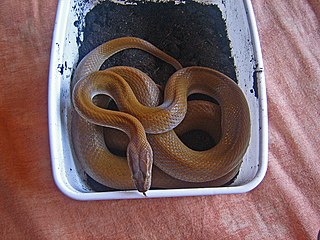
Viperinae, or viperines, are a subfamily of vipers endemic to Europe, Asia and Africa. They are distinguished by their lack of the heat-sensing pit organs that characterize their sister group, the subfamily Crotalinae. Currently, 13 genera are recognized. Most are tropical and subtropical, although one species, Vipera berus, even occurs within the Arctic Circle. Like all vipers, they are venomous.

Scelotes is a genus of small African skinks.

Ichnotropis is a genus of African lizards in the family Lacertidae. Species in the genus Ichnotropis are commonly called rough-scaled lizards.

Tropidosaura is a genus of wall lizards of the family Lacertidae. The genus is endemic to southern Africa.

Boiga is a large genus of rear-fanged, mildly venomous snakes, known commonly as cat-eyed snakes or simply cat snakes, in the family Colubridae. Species of the genus Boiga are native to southeast Asia, India, and Australia, but due to their extremely hardy nature and adaptability, have spread to many other suitable habitats around the world. There are 38 recognized species in the genus. According to the study done by Jiří Smíd regarding Old World cat snakes, the ancestor of the cat snake originated in Africa, from where it diversified and expanded to other countries. Despite this diversity however, the different species have very similar needs in terms of temperature and precipitation.

Leopold Joseph Franz Johann Fitzinger was an Austrian zoologist.

The Natricinae are a subfamily of colubroid snakes, sometimes referred to as a family (Natricidae). The subfamily comprises 36 genera. Members include many very common snake species, such as the European grass snakes, and the North American water snakes and garter snakes. Some Old World members of the subfamily are known as keelbacks, because their dorsal scales exhibit strong keeling.
Dromophis is a genus of colubrid snakes. There are two commonly accepted species in the genus Dromophis:
Gonionotophis is a genus of snakes, known commonly as African ground snakes and file snakes, in the family Lamprophiidae. The genus is endemic to Central Africa.

The Colubrinae are a subfamily of the family Colubridae of snakes. It includes numerous genera, and although taxonomic sources often disagree on the exact number, The Reptile Database lists 717 species in 92 genera as of September 2019. It is the second largest subfamily of colubrids, after Dipsadinae. Many of the most commonly known snakes are members of this subfamily, including rat snakes, king snakes, milk snakes, vine snakes, and indigo snakes.

Lycodon is a genus of colubrid snakes, commonly known as wolf snakes. The Neo-Latin name Lycodon is derived from the Greek words λύκος (lykos) meaning wolf and οδόν (odon) meaning tooth, and refers to the fang-like anterior maxillary and mandibular teeth. They are nonvenomous, but many members of this genus strongly resemble the venomous kraits in appearance, an example of Emsleyan mimicry.

Psammophis is a genus of snakes in the family Psammophiidae. The genus comprises 33 species, which are found in Africa and Asia. Psammophis are diurnal and prey on lizards and rodents which they actively hunt. All species in the genus are venomous, and the venom is considered mild and not dangerous to humans.

Lycophidion is a genus of nonvenomous lamprophiid snakes commonly referred to as the wolf snakes.
The striped swamp snake, also known as the African swamp snake, is a species of colubrid snake. It is one of two members of the genus Dromophis. It is found in several African countries, including Burkina Faso, Senegal, Guinea-Bissau, Mali, Ivory Coast, Togo, Ghana, Benin, Niger, Nigeria, and Cameroon.

The common brown water snake is a species of nonvenomous, South African, snake.

The Lamprophiidae are a family of snakes found throughout much of Africa, including the Seychelles. There are 89 species as of July 2022.

Sibon is a genus of snakes found in northern South America, Central America and Mexico.

Lamprophiinae is a subfamily of lamprophiid snakes, a large group of mostly African snakes, most of which were formerly classified as colubrids but which we now know are actually more closely related to elapids.

Lycodonomorphus inornatus, commonly known as the olive house snake, the black house snake, and the olive ground snake, is a species of nonvenomous snake in the family Lamprophiidae. The species is endemic to southern Africa. It is a nocturnal snake with terrestrial habits.
















